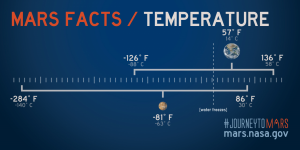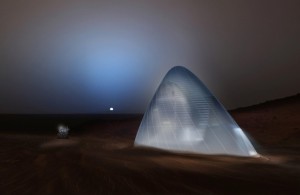Thin, only 1% as massive as atmosphere of Earth atmosphere of Mars and its greater distance from the Sun makes Mars much colder than Earth. According to NASA, the average temperature is about minus 81 degrees F (minus 63 degrees C)
, although it can vary from minus 284 degrees F (minus 140 degrees C) during the winter near the poles to 86 degrees F (30 degrees C) at midday near the equator. Since the average temperature on Mars is a very low, any shelter built above ground would
have to use massive thermal insulation. The thin Martian atmosphere will also require the shelters to be air tight,” and so, airlocks would be needed to prevent the oxygen enriched breathable air from escaping into the Martian atmosphere as the Martian workers enter or leave the shelters.
In accordance with results of the research carried out by Nasa’s Curiosity rover and posted in the Italian “In a Bottle” magazine, “The presence of water is traditionally considered an essential ingredient for life as we know it. However, as the scientists point out, there are other factors which still make
Mars a hostile environment. The first of these is its magnetic field. The earth’s magnetic field protects us from harmful cosmic radiation.” So, one of several challenges is to decide how can we protect ourselves from this radiation.
According to well-reasoned opinions posted on the website of David A. Johnson, multi-layer reflective type plastic films could be used for shelters. “The films need to be designed so visible sunlight light would pass into the shelter but would block infrared heat light from escaping. This technique is often used in green houses on earth using panes of
glass to trap the heat. But, shelters that are built above ground using thin insulating walls may not be the best solution for the permanent citizens of Mars. Because the atmosphere of Mars is so thin and since Mars has a very weak magnetic field, Mars may have much higher radiation levels from the sun and space than on earth. The thick atmosphere and strong magnetic field on earth naturally shields the humans from such harmful radiation. Long term exposure to such radiation on Mars may cause genetic damage in humans. One way to lower the radiation levels is to place the living quarters for the Martian settlers below ground.” Apparently, a bunch of underground shelters related proposals as well as many others has been reviewed in NASA before they selected the best of them. A proposal made as result of collaborative work of two teams named “Clouds AO” (Clouds Architecture Office) and “SEArch” (Space Exploration Architecture) has won NASA’s Mars Habitat Competition. Initially, they were just two among thirty of other finalists in the 3D Printed Habitat Challenge organized by America Makes and NASA. As it stated in one of the ArchDaily articles published by Karissa Rosenfield, being sponsored by NASA and America Makes, in NASA’s Mars Habitat Competition all “Teams
were asked to use indigenous materials and 3D printing techniques to build a habitat for four astronauts on Mars.” SEArch and Clouds AO became ahead of 30 other shortlisted practices. They won the first prize proposal for their idea of the “ICE HOUSE.”
As it stated in Karissa’s article, “Recognizing that water is the building block to life, the team used a ‘follow the water’ approach to conceptualize, site and construct their design,” said SEArch and Clouds AO. “[Our] proposal stood out as one of the few entries not to bury the habitat beneath regolith, instead mining the anticipated abundance of subsurface ice in the northern regions to create a thin vertical ice shell capable of protecting the interior habitat from radiation while celebrating life above ground.” The graphical picture below represents how the SEArch and Clouds AO’s “ICE HOUSE” may looks like being implemented on Mars.
According to Karissa, the winning team states that “The architecture of ICE HOUSE celebrates the presence of a human habitat as a beacon of light on the Martian surface. The design emerged from an imperative to bring light to the interior and to create visual connections to the landscape beyond, allowing the mind as well as the body to thrive. While scientists have experimented with what could potentially be synthetic replacements for sunlight, artificial substitutes do not hold nearly the same circadian variance or ability to balance a crew’s mental and physical health as does experiencing the sun’s actual and unmediated daily cycles. The water ice counteracts the traditional danger of living above ground by serving as a radiation barrier, offsetting fears of solar exposure that have, until now, projected Martian architecture into a dark underworld—buried beneath” a regolith, the surface layer of Mars that is “…believed to contain perchlorates, gypsum and other substances hazardous to human life.”
As it stated by Alexandra Witze in her Science News’ article “Year in review: Best evidence yet for water on Mars,” “water on Mars has been reported many times in the past, with each discovery adding fresh nuance to scientists’ picture of the planet.” Fiona Macdonald in her article at www.sciencealert.com also notices that “Last year, we all got really excited when scientists announced the most compelling evidence so far that salty, liquid water flows on Mars. Now researchers have revealed that something even more incredible is likely happening on the Red Planet – that flowing water is also boiling.” Reviewing the resent Martian shelters’ proposals, we may notice that most of them are based on the utilization of Martian water as one of the most important parts of the other heavy by weight and therefore too difficult to be delivered to these planet materials which are assumed to be found on Mars. The scientists are still arguing the not straight ahead facts and several based on them assumptions regarding the water existence on Mars. So, one of the most reasonable questions is: Will water ever be found on Mars?
article with all pictures and citations here: Shelter





